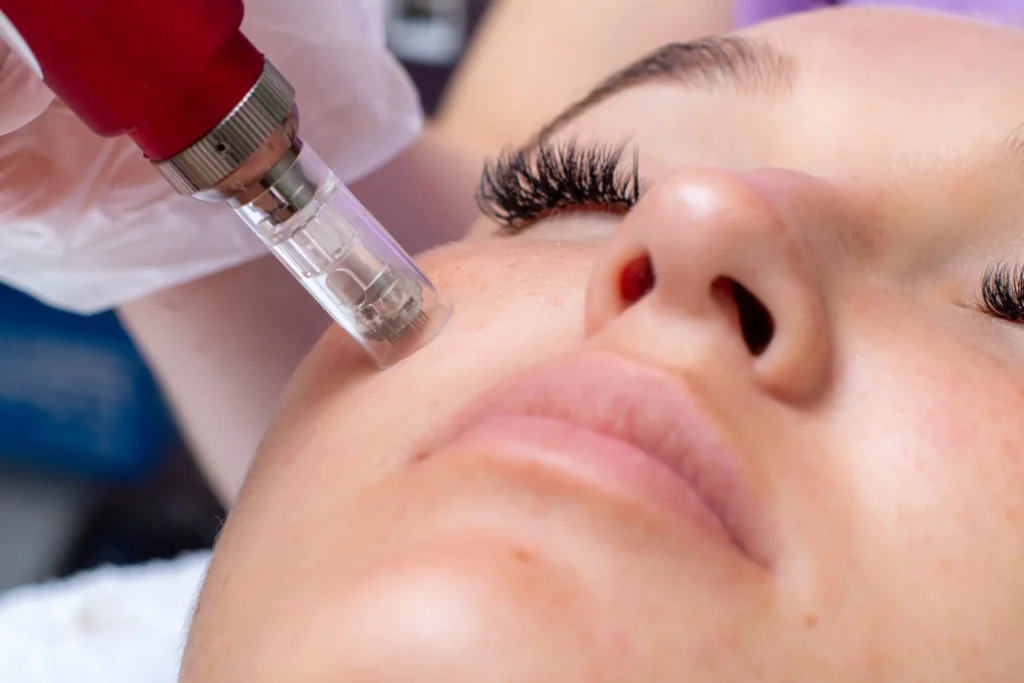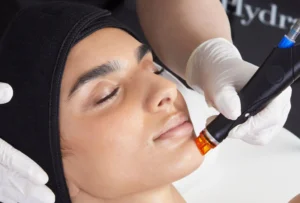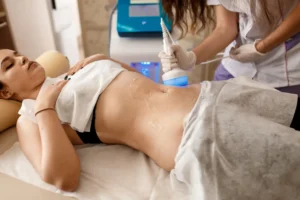Are you on a quest for smoother, more radiant skin that exudes confidence and vitality? If so, you’ve likely stumbled upon the transformative power of microneedling—a skincare sensation that’s taking the beauty world by storm. But amidst the myriad of options, one name stands out: eDermaStamp Microneedling. This cutting-edge treatment harnesses the latest in skincare technology to rejuvenate and revitalize your complexion like never before. Yet, as you embark on your skincare journey, one burning question lingers: How often should I get microneedling? Fear not, because we’re about to unravel the secrets to achieving optimal results and glowing skin with eDermaStamp Microneedling.
How Microneedling Works
Microneedling, also known as collagen induction therapy, is a minimally invasive cosmetic procedure that involves the use of a device equipped with fine needles to create controlled micro-injuries on the skin’s surface. While the concept may sound intimidating at first, the process is quite fascinating and yields remarkable benefits for the skin. Let’s delve into how micro-needling works and why it’s hailed as a game-changer in the world of skincare:
Stimulating Collagen Production
At the heart of microneedling lies its ability to stimulate collagen production—a key protein responsible for maintaining the skin’s structure, elasticity, and youthful appearance. When the tiny needles penetrate the skin’s surface, they create microscopic channels or “micro-injuries,” triggering the body’s natural healing response.
Activating the Healing Process
As the skin perceives these micro-injuries, it initiates a cascade of healing processes, including the production of new collagen and elastin fibers. These structural proteins work to repair and remodel the skin, leading to improvements in texture, firmness, and overall quality.
Enhancing Product Absorption
The microchannels created during micro-needling also enhance the absorption and penetration of topical skincare products. This means that any serums, moisturizers, or growth factors applied to the skin immediately following the procedure can penetrate deeper into the skin, maximizing their effectiveness and delivering optimal results.
Addressing Various Skin Concerns
Microneedling is a versatile treatment that can target a wide range of skin concerns, including fine lines and wrinkles, acne scars, hyperpigmentation, enlarged pores, and uneven texture. By promoting collagen production and skin regeneration, microneedling can help improve the appearance of these common skincare issues.
Customization for Individual Needs
One of the key advantages of microneedling is its versatility and ability to be tailored to individual skin types and concerns. The depth of the needles can be adjusted based on the specific area being treated and the severity of the condition, allowing for precise targeting and optimal results.
Minimal Downtime and Side Effects
Unlike more invasive procedures such as laser resurfacing or chemical peels, microneedling typically involves minimal downtime and side effects. Most patients experience mild redness and swelling immediately following the procedure, which subsides within a few days. The controlled nature of microneedling also reduces the risk of complications or adverse reactions.
Progressive Improvement Over Time
While some initial results may be visible shortly after the first treatment, the full benefits of microneedling often become more apparent with each subsequent session. This is because collagen production continues to increase over time, leading to progressive improvement in skin texture, tone, and overall appearance.
Factors That May Determine How Often to Get eDermaStamp Microneedling Treatments
The frequency of eDermaStamp microneedling treatments can vary depending on several factors, including individual skin concerns, treatment goals, skin type, and the advice of a skincare professional. Here are some factors that may determine how often to get eDermaStamp microneedling treatments:
Skin Concerns
The severity of your skin concerns, such as acne scars, wrinkles, or hyperpigmentation, can influence the frequency of treatments. More severe concerns may require more frequent sessions initially.
Treatment Goals
Your desired outcome will also play a role. If you’re looking for significant improvement in skin texture or tone, you may need more frequent treatments initially compared to someone seeking maintenance or preventive care.
Skin Type and Sensitivity
Individuals with sensitive skin may need to space out treatments more than those with resilient skin types. Your skincare professional will consider your skin’s sensitivity and adjust the treatment frequency accordingly.
Healing Capacity
Everyone’s skin heals at a different rate. Some individuals may require more time between treatments to allow their skin to fully recover, while others may tolerate more frequent sessions.
Response to Treatment
Your skin’s response to microneedling treatments will also influence the frequency. If your skin responds well and heals quickly, you may be able to schedule treatments more frequently.
Professional Recommendation
It’s crucial to follow the advice of a qualified skincare professional or dermatologist. They will assess your skin condition, monitor your progress, and recommend the appropriate interval between treatments based on your individual needs.
Combination with Other Treatments
If you’re combining microneedling with other skincare treatments, such as chemical peels or laser therapy, the frequency of microneedling sessions may be adjusted to complement these treatments and avoid overstimulating the skin.
Maintenance vs. Intensive Treatment
After achieving your desired results, you may transition to a maintenance schedule, which typically involves less frequent treatments to sustain the improvements. On the other hand, if you’re undergoing an intensive treatment regimen, sessions may be more frequent initially.
Age and Hormonal Factors
Age and hormonal changes can affect skin renewal and healing processes. Younger individuals may require fewer treatments compared to older individuals due to differences in skin regeneration rates.
Budget and Time Constraints
Practical considerations such as budget and scheduling availability may also influence the frequency of treatments. Balancing your skincare goals with these constraints is important when determining treatment intervals. It’s essential to consult with a skincare professional who can evaluate your skin condition, discuss your goals, and create a personalized treatment plan tailored to your needs and circumstances. Additionally, be sure to follow post-treatment care instructions provided by your skincare professional to optimize results and minimize any potential risks or side effects.
How Often Should You Do Microneedling Treatments?
Microneedling is a popular skincare treatment known for its ability to rejuvenate the skin and address various concerns such as fine lines, wrinkles, acne scars, and uneven texture. However, determining the ideal frequency of microneedling treatments depends on several factors, including your skin type, specific concerns, and treatment goals. Here’s a comprehensive guide to help you navigate the question: How often should you do microneedling treatments? Read on “What Are the Benefits of eDermaStamp Microneedling?” and explore the transformative power of microneedling.
General Guidelines
For most individuals seeking overall skin rejuvenation and maintenance, scheduling microneedling treatments every 4 to 6 weeks is a good starting point. This interval allows for adequate healing time between sessions while maximizing the cumulative benefits over time.
Skin Concerns and Goals
If you’re targeting specific skincare concerns such as acne scars, hyperpigmentation, or stretch marks, you may benefit from more frequent microneedling sessions. Depending on the severity of your concerns, sessions can be spaced approximately 3 to 4 weeks apart to achieve optimal results. Individuals with more advanced signs of aging or stubborn skin issues may require a more aggressive treatment approach, with sessions scheduled every 2 to 4 weeks initially, followed by maintenance treatments at longer intervals.
Skin Type and Sensitivity
It’s essential to consider your skin’s sensitivity and tolerance to microneedling when determining the frequency of treatments. Those with sensitive or easily irritated skin may need longer intervals between sessions to allow for proper healing and minimize the risk of adverse reactions. Conversely, individuals with resilient skin may tolerate more frequent treatments, but it’s crucial to avoid overdoing it to prevent skin damage or inflammation.
Consultation with a Skincare Professional
Before embarking on a microneedling regimen, it’s highly recommended to consult with a qualified skincare professional. During your consultation, your provider will assess your skin’s condition, discuss your concerns and goals, and recommend a personalized treatment plan tailored to your needs. Your skincare provider will take into account factors such as your skin type, medical history, and any previous treatments to determine the most appropriate frequency of microneedling sessions for you.
Maintenance and Long-Term Care
Once you’ve achieved your desired results, transitioning to a maintenance schedule is crucial for preserving the benefits of microneedling and sustaining your skin’s improvements over time. Many individuals opt for quarterly or semi-annual touch-up sessions to maintain their results and address any new concerns that may arise.
Treatments to Maintain Results
Once you’ve undergone a series of microneedling treatments and achieved the radiant skin you’ve been dreaming of, the next step is to maintain those impressive results. After all, investing in your skin’s health and beauty is an ongoing process. Thankfully, there are several effective treatments and practices you can incorporate into your skincare routine to ensure that your skin remains smooth, youthful, and vibrant. Let’s delve into some tried-and-tested methods for maintaining your micro-needling results:
Regular Moisturizing
Keeping your skin well-hydrated is essential for maintaining its elasticity and suppleness. Invest in a high-quality moisturizer that suits your skin type and use it consistently to lock in moisture and support your skin’s natural barrier function.
Sun Protection
Shielding your skin from harmful UV rays is crucial for preventing premature aging and protecting the results of your microneedling treatments. Apply a broad-spectrum sunscreen with an SPF of 30 or higher daily, even on cloudy days, and reapply as needed, especially if you’ll be spending extended periods outdoors.
Topical Treatments
Incorporating targeted skincare products into your routine can help enhance and maintain the results of microneedling. Look for serums or creams containing ingredients like hyaluronic acid, vitamin C, and peptides, which can support collagen production, improve skin texture, and promote overall skin health.
Gentle Exfoliation
Regular exfoliation can help remove dead skin cells and promote cell turnover, revealing fresher, brighter skin underneath. Opt for gentle exfoliants such as alpha hydroxy acids (AHAs) or beta hydroxy acids (BHAs) to prevent irritation and maintain the smoothness of your complexion.
Hydrating Masks
Treat your skin to a hydrating mask once or twice a week to replenish moisture and nourish your complexion. Look for masks containing ingredients like hyaluronic acid, aloe vera, and ceramides to soothe, hydrate, and revitalize your skin.
Occasional Touch-Up Treatments
Depending on your skincare goals and individual needs, scheduling occasional touch-up microneedling treatments can help maintain the results of your initial series. These touch-up sessions can be spaced out over longer intervals, such as every 6 to 12 months, to refresh your skin and address any new concerns that may arise.
Healthy Lifestyle Habits
Remember that skincare isn’t just about what you put on your skin—it’s also about how you treat your body overall. Get plenty of sleep, eat a balanced diet rich in fruits and vegetables, stay hydrated, and manage stress levels to support your skin’s health and vitality from the inside out.
Wrapping Up
In conclusion, eDermaStamp Microneedling stands as a revolutionary skincare treatment that harnesses the body’s natural healing processes to rejuvenate and revitalize the skin. By creating controlled micro-injuries and stimulating collagen production, microneedling offers a versatile solution for addressing a wide range of skincare concerns, from fine lines and wrinkles to acne scars and hyperpigmentation. With its customizable approach, minimal downtime, and impressive results, it’s no wonder that microneedling has become a go-to treatment for achieving smoother, more youthful-looking skin. So, whether you’re embarking on your first microneedling journey or considering maintenance treatments, remember to consult with a skincare professional to determine the optimal frequency for your individual needs and skincare goals. Here’s to radiant skin and confidence that shines from within—thanks to the transformative power of eDermaStamp Microneedling!
Ready to take your skincare routine to the next level? At Roha MedSpa, we’re here to help you achieve radiant, youthful-looking skin with our expert microneedling treatments. Say goodbye to fine lines, acne scars, and uneven texture—schedule your appointment today and experience the transformative results of microneedling at Roha MedSpa. Your skin deserves the best, so why wait? Join us and discover the perfect frequency for your microneedling sessions to reveal a complexion that radiates confidence and beauty.
FAQs: How Often Should I Get Microneedling
How often should I get microneedling to see noticeable results?
Generally, a series of 3 to 6 microneedling sessions spaced 4 to 6 weeks apart is recommended to achieve optimal results. Consistency in treatment frequency is key to stimulating collagen production and seeing visible improvements in skin texture and tone.
Is there a recommended maintenance schedule for microneedling after the initial sessions?
After completing the initial series of treatments, many individuals opt for quarterly or semi-annual touch-up sessions to maintain the results. This maintenance schedule helps sustain collagen production and prolong the benefits of microneedling over time.
Can I undergo microneedling more frequently for faster results?
While it may be tempting to schedule microneedling sessions closer together, it’s important to allow adequate time for your skin to heal and regenerate between treatments. Overdoing it can lead to overstimulation and potential damage to the skin’s barrier.
How do I know if I need more or fewer microneedling sessions?
Your skincare provider will assess your skin’s condition and treatment goals to determine the ideal frequency of microneedling sessions for you. Factors such as skin type, concerns, and response to treatment will guide the recommendation for more or fewer sessions.
Are there any side effects or risks associated with microneedling?
While microneedling is generally safe when performed by a trained professional, some temporary side effects may occur, such as redness, swelling, and mild discomfort. Following post-treatment care instructions and adhering to the recommended treatment frequency can help minimize risks and ensure optimal results.







